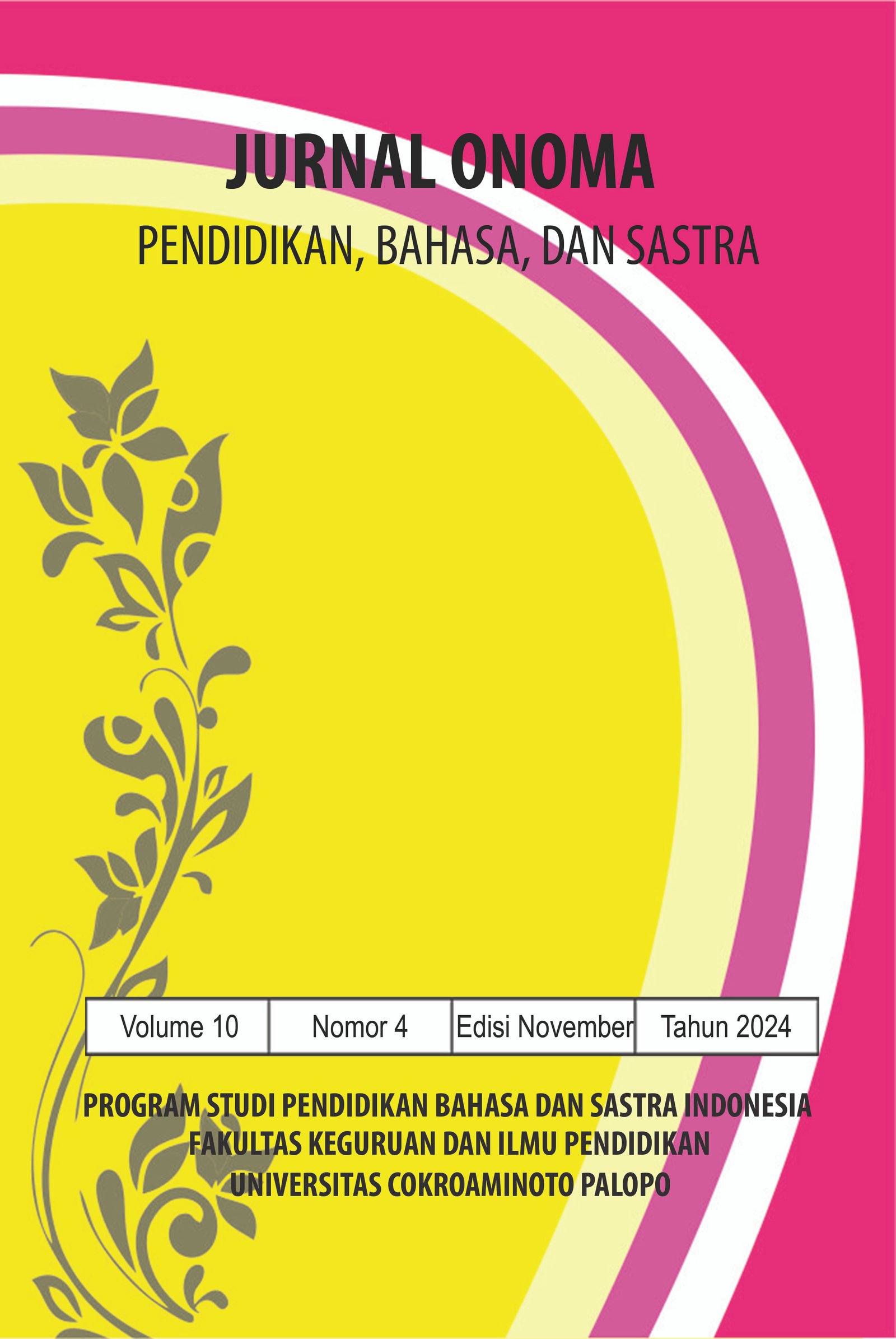Analisis Pola Kalimat dalam Buku Terjemahan Atomic Habits Karya James Clear
https://doi.org/10.30605/onoma.v10i4.4717
Keywords:
Sintaksis, Pola Kalimat, Novel, Atomic Habits, Linguistik.Abstract
Penelitian ini berfokus pada aspek sintaksis, khususnya dalam mengidentifikasi bentuk dan struktur pola kalimat yang digunakan dalam novel. Penelitian ini bertujuan untuk mendeskripsikan pola-pola kalimat dalam novel terjemahan Atomic Habits karya James Clear. Penelitian ini dibatasi pada analisis pola-pola kalimat dalam novel Atomic Habits karya James Clear yang diterjemahkan oleh Alex Tri Kantjono Widodo. Jenis penelitian ini adalah kualitatif dengan menggunakan metode deskriptif. Pengumpulan data dalam penelitian ini menggunakan teknik baca dan teknik catat. Teknik analisis data berupa kondensasi data, penyajian data, dan verifikasi data. Berdasarkan hasil penelitian dan pembahasan, dapat disimpulkan bahwa bentuk-bentuk atau jenis pola kalimat yang teridentifikasi dalam novel Atomic Habits karya James Clear yang telah diterjemahkan oleh Alex Tri Kantjono Widodo terdiri atas, (1) kalimat berpola S – P, (2) kalimat berpola S – P – O, (3) kalimat berpola S – P – Pel, (4) kalimat berpola S – P – K, (5) kalimat berpola S – P – O – Pel, dan (6) kalimat berpola S – P – O – K. Penggunaan pola kalimat dalam novel tersebut didominasi oleh kalimat-kalimat yang berpola S – P – O – K dengan jumlah penggunaan yaitu 133 pola. Sedangkan pola kalimat yang jarang penggunaannya adalah pola S – P yang berjumlah 26 pola.
Downloads
References
Alamsyah, A., & Sumarni, L. (2024). Kampanye Public Relations (Edukasi dan Kolaborasi) dalam Tingkat Kesadaran Masyarakat Akan Penggunaan Air Bersih:(Studi Deskriptif Kualitatif Pada Sobat Air Jakarta). Harmoni: Jurnal Ilmu Komunikasi dan Sosial, 2(3), 331-345.
Clear, J. (2019). Atomic Habits. PT Gramedia Pustaka Utama anggota IKAPI, Jakart, 15-217.
Dressman, M. & Randall, W., S. 2020. The Handbook of Informal Language Learning, First Edition. John Wiley & Sons Ltd. https://doi.org/10.1002/9781119472384.ch9 DOI: https://doi.org/10.1002/9781119472384
Efendi, M. S. (2012). Linguistik sebagai Ilmu Bahasa. Jurnal Perspektif Pendidikan, 5(1), 97-101.
Kasmanah, K., Anwar, M., & Rohman, S. (2024). Pola Kalimat Opini Gubernur dalam JawaPos untuk Komunikasikan Hari Guru Nasional. Adjektiva: Educational Languages and Literature Studies, 7(1), 11-20.
Kenneth D. Keith. (2013). The Encyclopedia of Cross-Cultural Psychology, First Edition. John Wiley & Sons, Inc. https://doi.org/10.1002/9781118339893.wbeccp325 DOI: https://doi.org/10.1002/9781118339893
Khairani, K., Anisa, I., Pratiwi, P., Putri, N. A., Kuntarto, E., & Noviyanti, S. (2018). Peran, Fungsi, dan Kedudukan Bahasa dalam Kehidupan Sehari-Hari. Repository Unja.
Kirana, H. (2017). Pola Kalimat dalam Novel Laskar Pelangi Karya Andrea Hirata. Skripsi. Universitas Sembilanbelas November Kolaka.
Laia, M. (2023). Analisis Pola Kalimat Dasar Bahasa Nias Utara Dialek Tengah di Desa Sifalagӧ Susua Kecamatan Susua Kabupaten Nias Selatan: Kajian Sintaksis. Kohesi: Jurnal Pendidikan Bahasa dan Sastra Indonesia, 3(2), 36-43. https://doi.org/10.57094/kohesi.v3i2.850 DOI: https://doi.org/10.57094/kohesi.v3i2.850
Liusti, S. A. (2016). Analisis Kalimat Berdasarkan Pola Kalimat Dasar dan Kalkulus Predikat. Adabiyyat: Jurnal Bahasa dan Sastra, 15(2), 157-175. DOI: https://doi.org/10.14421/ajbs.2016.15203
Mailani, O., Nuraeni, I. ., Syakila, S. A. ., & Lazuardi, J. . (2022). Bahasa sebagai Alat Komunikasi dalam Kehidupan Manusia. Kampret Journal, 1(2), 1–10. https://doi.org/10.35335/kampret.v1i1.8 DOI: https://doi.org/10.35335/kampret.v1i1.8
Nhat, P. H. (2020). Kemampuan Menentukan Klausa Bahasa Indonesia Siswa Kelas 8 E, F Labschool Palu. Jurnal Bahasa dan Sastra, 5(2), 33-42.
Purwaningsih, E. (2018). Pola Kalimat dalam Berita Utama Koran Tribun Lampung Mei—Juni 2017 dan Implikasinya Terhadap Pembelajaran Bahasa Indonesia di SMP. Iso 90.
Putranto, R. A., Inayati, D., Ayumahardika, P., & Safira, R. A. (2023). Terampil Membaca dan Menulis Bahasa Indonesia SD. Cahya Ghani Recovery.
Putri, R., & Yurni, Y. (2020). Struktur Klausa Dasar Bahasa Indonesia dalam Surat Kabar Republika. Islamic Manuscript of Linguistics and Humanity, 2(1), 12-21.
Rifaldy, M., Sasterio, S., & Natsir, N. (2024). Implementasi Kebijakan Pemberian Tambahan Penghasilan Bagi Pegawai Negeri Sipil di Biro Umum Provinsi Sulawesi Tengah. JURNAL SYNTAX IMPERATIF: Jurnal Ilmu Sosial dan Pendidikan, 5(3), 531-547.
Suparman, S. (2024). Konteks Budaya Perkawinan Masyarakat Bugis Luwu (Kajian Antropolinguistik). DEIKTIS: Jurnal Pendidikan Bahasa dan Sastra, 4(3), 233-238. DOI: https://doi.org/10.53769/deiktis.v3i4.559
Shofwah, N. (2022). Analisis Frasa, Klausa, dan Kalimat dalam Novel Romiowa Juliet Karya William Shakespeare Kajian Sintaksis (Doctoral dissertation, Universitas Nasional).
Wahyuni, R. T. (2019). Analisis Pola, Fungsi, Kategori, dan Peran Sintaksis pada Kalimat Tunggal dalam Surat Kabar Harian Kompas Serta Relevansinya dengan Pembelajaran Bahasa Indonesia di SMP (Doctoral dissertation, IKIP PGRI BOJONEGORO). http://repository.ikippgribojonegoro.ac.id/id/eprint/72
Zufferey, S. 2020. Introduction to Corpus Linguistics. Great Britain and the United States by ISTE Ltd and John Wiley & Sons, Inc. https://doi.org/10.1002/9781119779728.ch1 DOI: https://doi.org/10.1002/9781119779728
Downloads
Published
How to Cite
License
In submitting the manuscript to the journal, the authors certify that:
- They are authorized by their co-authors to enter into these arrangements.
- The work described has not been formally published before, except in the form of an abstract or as part of a published lecture, review, thesis, or overlay journal.
- That it is not under consideration for publication elsewhere,
- That its publication has been approved by all the author(s) and by the responsible authorities – tacitly or explicitly – of the institutes where the work has been carried out.
- They secure the right to reproduce any material that has already been published or copyrighted elsewhere.
- They agree to the following license and copyright agreement.
License and Copyright Agreement
Authors who publish with Onoma Journal: Education, Languages??, and Literature agree to the following terms:
- Authors retain copyright and grant the journal right of first publication with the work simultaneously licensed under Creative Commons Attribution License (CC BY 4.0) that allows others to share the work with an acknowledgment of the work's authorship and initial publication in this journal.
- Authors are able to enter into separate, additional contractual arrangements for the non-exclusive distribution of the journal's published version of the work (e.g., post it to an institutional repository or publish it in a book), with an acknowledgment of its initial publication in this journal.
- Authors are permitted and encouraged to post their work online (e.g., in institutional repositories or on their website) prior to and during the submission process, as it can lead to productive exchanges, as well as earlier and greater citation of published work.

















